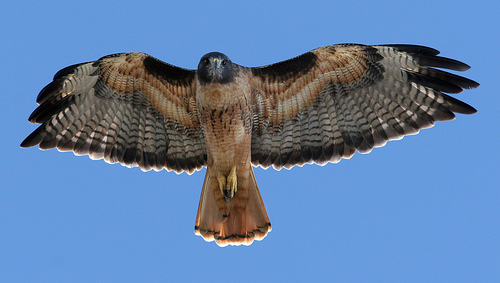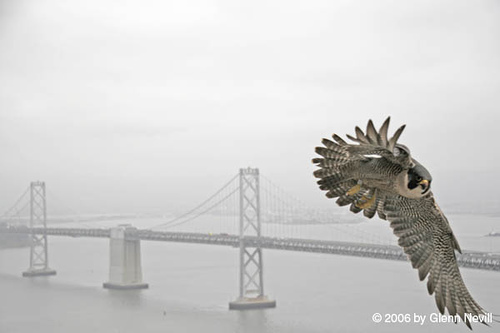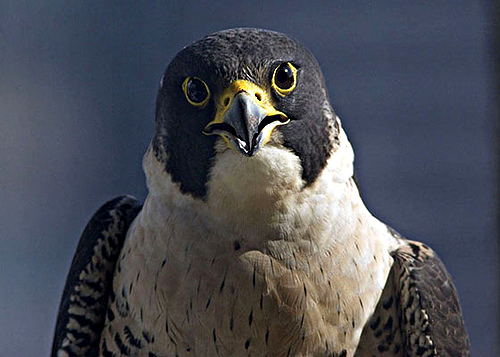Falconry is tightly regulated at both the state and federal level. To own a bird, you need a license, and you need to apprentice with an experienced falconer for two years. Once you’ve completed your apprenticeship, you can get a general license and own up to three birds, of almost any species. With a master license, you can own up to 5 birds. After you’ve had a master license for 7 years, you can own an eagle. The California Hawking Club and the North American Falconers Association have more information about the licensing and practice of falconry.

Red-tailed Hawk. Photo: Ron Wolf at kqedquest.
Rikki has a Red-tailed Hawk, named Nut, which he trapped in the wild last year. There are strict rules about how and when falconers can catch birds. Only passage birds—sexually immature birds less than a year old and on their first migration— can be caught. And falconers can only catch certain species. Many species, including endangered birds, are off-limits. However, falconers can get rare birds, like Peregrine Falcons, from captive breeding programs. Rikki intends to free Nut when she is three years old, when she’s old enough to breed. Because she was caught in the wild, and learned to hunt on her own before she hunted with Rikki, he can return her to the wild. Birds from captive breeding programs cannot be released. When captive-bred birds get old and can no longer hunt effectively, they can go back into captive breeding programs, or be cared for a by a zoo, like Bella.
Rikki flies Nut every day at a local park, and she hunts a few times a week. Each time Nut catches prey, she brings it back to Rikki. He rewards her with food—most of the time, prey that she has previously caught. The idea that the raptor is hunting for the human is controversial—anyone who is against hunting would probably be against falconry. And the concept that a wild animal is kept in captivity can definitely ruffle some feathers. Rikki counters these arguments: Nut would hunt without him, he says, and would probably hunt more often, because she can’t store the leftovers in the freezer. And Rikki contends that his relationship with Nut is the same as any relationship a human has with an animal—a dog, a cat, a horse—it’s just a little less common. However, Red-tailed Hawks haven’t been domesticated for generations like dogs and cats; Nut was born wild.

A Peregrine Falcon named Gracie flies by the Bay Bridge. Photo: Glenn Nevill at kqedquest.
While there are many objections to the practice of falconry, the Peregrine Falcon has falconers to thank for its continued existence. Peregrine Falcons were on the edge of extinction in the 1970s, because the pesticide DDT made their eggshells perilously thin. However, falconers had healthy Peregrine Falcons in captive breeding programs; offspring from these captive-bred falcons were carefully raised without human contact and were introduced to the wild. Because of these efforts and the ban of DDT, Peregrine Falcons were removed from the Endangered Species List in 1999.
Learn more about falcons in the Science on the SPOT story, Peregrine Falcons Up Close, and the QUEST story Falcon Fascination. Also, check out the falcon Nest Cam at San Jose City Hall.
37.8793 -122.245



